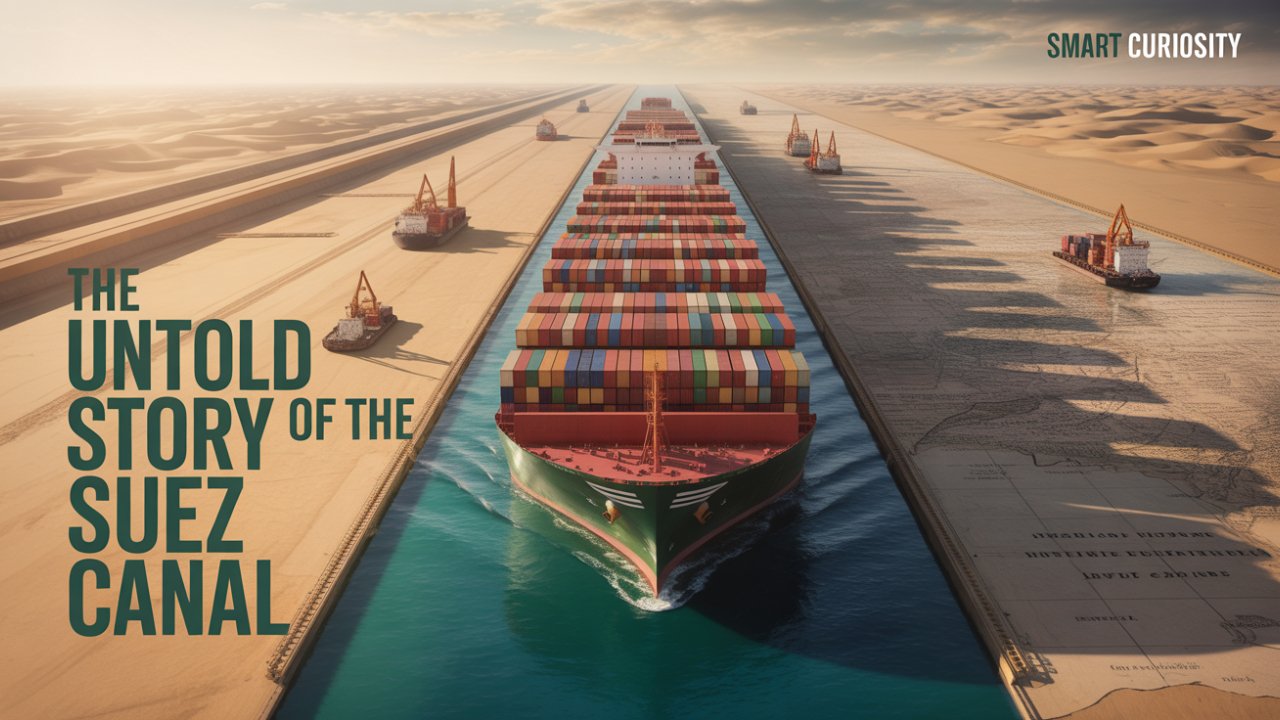Picture this: it’s March 2021, and the entire global economy is being held hostage… by a single ship, stuck in a ditch. For six days, the container ship Ever Given a vessel longer than the Eiffel Tower is tall was wedged completely across the Suez Canal, creating a traffic jam of world-stopping proportions. Hundreds of ships, loaded with everything from oil to iPhones, piled up on either side. The blockage halted an estimated ten billion dollars in trade every single day. News channels broadcast satellite images of the helpless giant, a symbol of modern commerce that was suddenly, embarrassingly, impotent. The world was glued to its screens, wondering, how on earth did this happen? How did a 120-mile shortcut through the Egyptian desert become so vital that one ship getting stuck could send shockwaves around the planet?
The story of the Suez Canal isn’t just about shipping lanes. It’s a story of ancient pharaohs and imperial schemers, of groundbreaking engineering and heartbreaking tragedy. It’s the untold story of a waterway built with blood, sweat, and ambition a ribbon of blue that has dictated the flow of power, wealth, and war for over 150 years. This is the story of how a line drawn in the sand changed everything.
The idea of connecting the Mediterranean and the Red Sea isn’t new. Not at all. It’s a dream as old as civilization itself, born in the minds of the pharaohs who ruled ancient Egypt. The problem was simple, but the scale was immense: geography. Back then, sailing from Europe to Asia meant a brutal, months-long journey all the way around Africa, at the mercy of storms and treacherous coastlines. The solution seemed obvious, at least on a map. A tiny strip of land, the Isthmus of Suez, was the only thing in the way. A canal would be a game-changer.
Ancient Egyptian rulers were the first to take a crack at it. As far back as the 19th century BCE, Pharaoh Senusret III is thought to have ordered the first canal. It wasn’t a direct link, but a clever workaround connecting the Red Sea to the Nile River, which then flowed into the Mediterranean. This “Canal of the Pharaohs” was an ancient marvel, expanded and re-dug for a thousand years by everyone from the Persian conqueror Darius the Great to the Greek Ptolemies.
But there was a catch. These early canals were a constant battle against nature. They were always silting up, always being reclaimed by the shifting desert sands. By the 8th century CE, the last of these ancient waterways was finally abandoned. The desert won, the dream was buried, and the long, dangerous route around the Cape of Good Hope once again became the world’s main maritime highway. For more than a thousand years, the dream of a direct canal lay dormant, waiting for a new era of ambition, technology, and sheer force of will to bring it back to life.
The 19th century arrived with the roar of steam engines and the relentless drive of the Industrial Revolution. Empires were expanding, markets were going global, and time was money. The long voyage around Africa was no longer just an inconvenience; it was a major bottleneck for capitalism. For Europe’s great powers, especially Britain and France, controlling the routes to their colonies in Asia was everything.
Into this game of imperial chess stepped a man with a single, all-consuming obsession: Ferdinand de Lesseps. Now, de Lesseps wasn’t an engineer. He wasn’t a banker. He was a charismatic French diplomat who had become mesmerized by the ancient dream of the canal. His plan was audacious: a direct, sea-level canal, 120 miles long, carved straight through the desert. No locks, no rivers, just a saltwater highway connecting the Mediterranean to the Red Sea.
De Lesseps was a master salesman. He framed the canal not as a French project, but as a gift to all humanity. He charmed the Egyptian viceroy, Sa’id Pasha, and in 1854, secured the deal to form the Suez Canal Company. With funding primarily from French investors and Sa’id Pasha himself, the stage was set for one of the greatest engineering projects in history.
Construction began on April 25, 1859. And this is where we find the dark secret at the heart of the canal’s story the horrific human cost that is so often left out of the official history. De Lesseps’s grand vision was built on the backs of forced peasant labor.
Under the deal, the Egyptian government was required to supply the workers. Tens of thousands of fellahin, or peasants, were rounded up from their villages, sometimes in chains, and marched into the desert to work under a system called the corvée. It was slavery in all but name. For the first few years, the work was brutally manual. The main tools were picks, shovels, and their bare hands. They dug out sand and rock, loading it into baskets they carried up the steep banks.
The conditions were inhuman. Fresh water was dangerously scarce. The workers were crammed into squalid camps that became breeding grounds for cholera, dysentery, and typhoid, which killed thousands. They were paid almost nothing and brutally disciplined by overseers. Over the decade of construction, it’s estimated that as many as 1.5 million Egyptians were forced to work on the project. While exact numbers are lost to history, it’s widely believed that tens of thousands perhaps as many as 120,000 perished. Their bodies were buried in unmarked mass graves in the very desert they were transforming. This was the price of progress.
This brutal system caused international outrage, especially from Britain, whose motives were less about humanity and more about geopolitics. The British saw the French-led project as a direct threat to their naval power and the route to India. They did everything they could to stop it. Finally, under immense international pressure, forced labor was banned in 1863.
This was a crisis for de Lesseps. Without free labor, how could he finish? The answer was technology. The company was forced to invest in the most advanced machinery of the day: massive, steam-powered dredgers and excavators that could do the work of thousands of men. The project went from a scene of ancient toil to a showcase of industrial might. It saved the canal, but the cost ballooned to more than double the original estimate, a staggering 433 million French francs.
Finally, in 1869, the canal was finished. The inauguration on November 17th was a party of unbelievable extravagance hosted by the new viceroy, Isma’il Pasha. Royalty from all over Europe attended. To mark the occasion, a grand new opera house was built in Cairo. And you’ve probably heard that Verdi’s famous opera, Aida, was commissioned for the grand opening. That’s a great story… but it’s not quite true. Aida wasn’t ready in time and actually premiered two years later. The opera performed for the inauguration was Verdi’s Rigoletto.
As Empress Eugénie of France led a procession of ships into the new canal, the world cheered a triumph of engineering. But beneath the spectacle lay the ghosts of the thousands who had died to make it possible.
The canal was an instant success, but for Egypt, it was a disaster. The crippling cost of construction and Isma’il Pasha’s lavish spending bankrupted the country. In 1875, he had to sell Egypt’s entire 44% stake in the Canal Company. In a brilliant political move, British Prime Minister Benjamin Disraeli, whose country had once tried to kill the project, swooped in and bought all of it for just four million pounds. In a single deal, Britain went from the canal’s biggest critic to its single largest shareholder. The waterway built on Egyptian land, with Egyptian bodies, was now effectively controlled by a foreign power.
And just like that, the Suez Canal went from being a “universal project” to a strategic jewel in the British Imperial crown. For the next 80 years, the canal was the jugular vein of British power, the shortcut to India and the oil fields of the Persian Gulf. In 1882, Britain invaded and occupied Egypt, cementing its military grip on the canal. The waterway promised to the world now belonged to London.
This, as you can imagine, did not sit well with the Egyptian people. It was a national humiliation. The Suez Canal Company, run from Paris, acted like a state within a state, raking in huge profits while Egypt saw almost nothing. The desire to reclaim their canal became the defining goal for a new generation of Egyptian nationalists.
And that simmering resentment found its champion in a fiery, charismatic army officer named Gamal Abdel Nasser. Nasser came to power in the 1952 Egyptian Revolution, a movement driven by a powerful urge to restore Egyptian pride and sovereignty. To him, the Suez Canal was the ultimate symbol of Western domination. Taking it back wasn’t just about economics; it was about liberation.
Nasser’s big moment arrived in 1956. He was trying to get funding for his own massive project, the Aswan High Dam. He’d gotten initial promises of help from the U.S. and Britain, but they got cold feet, angered by his Arab nationalist politics and his arms deals with the Soviet bloc. In July 1956, they pulled their funding offer.
Nasser was furious, but he was also opportunistic. On July 26, 1956, in a thunderous speech in Alexandria, he delivered his answer. He recounted the canal’s history, the lives lost, the profits drained. Then, in a moment of pure political theater, he uttered a code word “de Lesseps” the signal for his forces to seize the Canal Company’s offices. To the roaring crowd, he declared: “The Suez Canal has been nationalized! It is now an Egyptian company!”
In Egypt, people danced in the streets. Nasser was a hero. But in London and Paris, there was fury. They saw Nasser as a dictator, a “Mussolini on the Nile,” and they were determined to take the canal back by force.
What followed was a secret plot between Britain, France, and Israel. The plan: Israel would invade Egypt’s Sinai Peninsula. Britain and France would then demand that both sides withdraw from the canal. When Nasser inevitably refused, they’d have their excuse to invade, seize the canal, and kick him out of power.
On October 29, 1956, they put the plan into action. Israeli forces pushed into the Sinai. Britain and France issued their ultimatum, and after Nasser rejected it, they started bombing Egyptian airfields and dropping paratroopers into the canal zone. Militarily, it worked at first. But Nasser had one last card to play. He ordered dozens of ships to be sunk right in the middle of the canal, blocking it completely.
The invasion, however, turned into a catastrophic political miscalculation. The plotters had forgotten about the new superpowers. The Soviet Union threatened rocket attacks on London and Paris. More importantly, the United States was livid. President Eisenhower was furious at his allies for their colonial-era stunt. He put the squeeze on them, threatening to sell off U.S. holdings of British government bonds, a move that would have destroyed the British economy.
Checkmated, Britain was forced into a humiliating retreat, with France right behind. The Suez Crisis of 1956 was a turning point. It was a massive political win for Nasser. It signaled the end of Britain’s status as a global superpower. And most importantly, it confirmed that the Suez Canal finally belonged to Egypt. But its days as a flashpoint were not over. It was blocked again, this time for eight long years after the 1967 Six-Day War, becoming a fortified frontline. It finally reopened in 1975, a symbol of the fragile peace that had returned.
The story of the Suez Canal is a wild ride, a perfect example of how one piece of infrastructure can shape empires and define nations. If you’re finding this journey as fascinating as we do, please take a second to subscribe and hit that notification bell. It really helps us bring you more of the stories that shaped our world.
Once it reopened in 1975, the Suez Canal entered a whole new phase. It was no longer a symbol of colonial shame but a source of national pride and a powerful engine for the Egyptian economy. But the world was changing fast, and the 19th-century canal had a 21st-century problem: gigantism.
Ships were getting bigger. And bigger. And bigger. The new generation of supertankers and container ships, some stretching 400 meters long, were pushing the canal to its absolute limits. If the canal couldn’t adapt, it would become a historical relic. The solution was constant, expensive expansion.
The biggest upgrade came in 2015. In a massive project, a new 35-kilometer channel was dug parallel to the existing one. Dubbed the “New Suez Canal,” it allowed for two-way traffic, cutting down wait times and boosting capacity. It was a clear signal that Egypt was all-in on keeping the canal relevant.
But even that wasn’t enough to eliminate the risks. And then, on March 23rd, 2021, the nightmare scenario happened. The Ever Given, one of the largest container ships on the planet, was slammed by a sandstorm. The wind pushed the colossal vessel sideways, wedging it firmly into both banks. The ship was stuck, a giant cork in the world’s most important bottle.
The six-day global soap opera that followed perfectly captured the fragility of our modern world. The crisis spurred Egypt into action, accelerating plans to widen and deepen the very section of the canal where the ship got stuck, a project completed in early 2025 to improve safety.
But just as the world learned the lessons of the Ever Given, a new, more dangerous crisis blew up. Starting in late 2023, the Red Sea the southern entrance to the canal became a warzone. Houthi militants in Yemen began attacking commercial ships with drones and missiles in response to the conflict in Gaza.
The impact was immediate. The world’s biggest shipping companies weren’t willing to risk their crews and billion-dollar vessels. They started diverting their fleets all the way around Africa again, adding weeks and millions in fuel costs to their journeys. The result was catastrophic for the canal. Throughout 2024, traffic plummeted, with some reports showing monthly ship counts down by over 50% compared to the previous year. Revenue, which Egypt depends on, collapsed. It was a painful irony: after 150 years of politics and engineering, the biggest threat wasn’t a blockage in the canal, but a conflict hundreds of miles away.
And now, here in mid-2025, the situation is still tense. While some shipping is starting to trickle back, many of the world’s biggest carriers are still playing it safe, and the canal is operating far below its capacity a stark reminder that this vital global artery is still at the mercy of the region’s turmoil.
So, what is the story of the Suez Canal? At its heart, it’s a story about a dream a dream to conquer geography and shrink the planet. It was born from the ambition of pharaohs, built by the vision of a French diplomat, and paid for with the lives of countless Egyptian peasants. It was an engineering marvel that instantly became a tool of empire, a symbol of domination that fueled a revolution, and a source of pride that defined a nation’s fight for its soul.
For over a century and a half, this 120-mile strip of water has been at the center of world history. It’s been a catalyst for war, a prize for superpowers, and a mirror reflecting the delicate balance of the global economy. From the shovels of the fellahin to the giant dredgers of today, from Queen Victoria’s gunboats to the mega-ships they now serve, the canal is a testament to our drive to overcome any barrier.
Today, when you see a massive ship gliding silently through the desert, it’s more than just a boat in a channel. It’s the end result of this long, brilliant, and often brutal history. It’s a symbol of just how connected our world is… and a terrifying reminder of how easily those connections can be broken.
So, what do you think? What part of the canal’s wild history surprised you the most? Was it the forgotten tragedy of its construction, or its role in bringing down an empire? Let us know in the comments below. And for more stories about the engineering and events that have shaped our modern world, make sure you’re subscribed. Thanks for watching.





